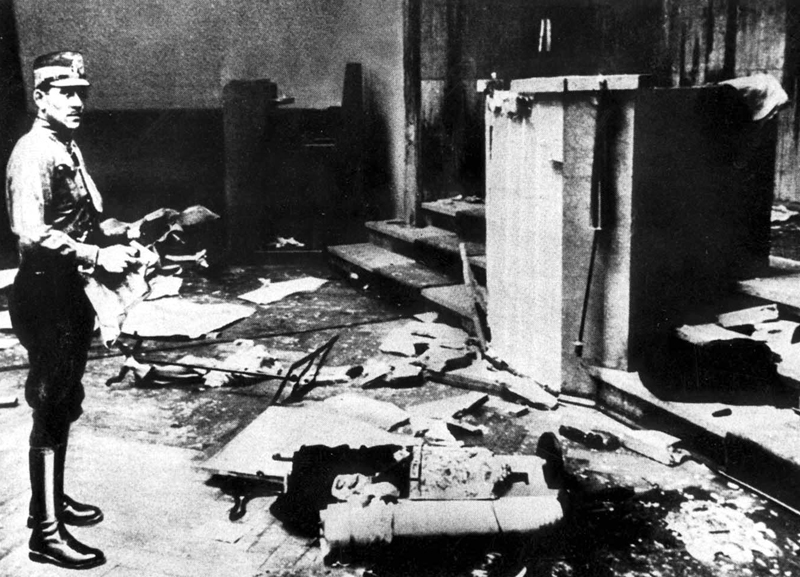Quellen
Heusler, Andreas: Synagoge Reichenbachstraße, in: Winfried Nerdinger (Hg.): Ort und Erinnerung. Nationalsozialismus in München, Salzburg u.a. 2006, S. 142.
Admission free
Jüdisch-Orthodoxes Gebetshaus in München

SA-Mann in der zerstörten Synagoge in der Reichenbachstraße, 10.11.1938 | Yad Vashem, 195_C122
Religiöse Konflikte zwischen liberalem Judentum und Orthodoxie hatten im Deutschen Reich im 19. Jahrhundert immer wieder zu Spannungen innerhalb der Gemeinden geführt und Spaltungen hervorgerufen. Galt es, an der Tradition der Vorväter im Glauben festzuhalten oder ging es in erster Linie darum, den Glauben an moderne Erfordernisse anzupassen?
Antisemitische Pogrome in Osteuropa, insbesondere im Zarenreich, zu Ende des 19. und Anfang des 20. Jahrhunderts führten zur Emigration vieler Jüdinnen*Juden, die u.a. in München eine neue Heimat fanden. Sie tendierten stärker zur Orthodoxie als die alteingesessene jüdische Bevölkerung, die der traditionellen Glaubensausübung der „Ostjuden“ teils skeptisch gegenüberstanden. Die Betvereine „Agudas Achim“ und „Linath Hazedek“ setzten sich für den Bau einer neuen orthodoxen Synagoge ein, um der auf über 2000 Anhänger angewachsenen Gemeinschaft der osteuropäischen Jüdinnen*Juden einen religiösen Mittelpunkt zu geben, da der 1914 in der Reichenbachstraße geschaffene Betsaal nicht mehr ausreichte.
Der Architekt Gustav Meyerstein errichtete im Hinterhof der Reichenbachstraße 27 die Synagoge, die 1931 eingeweiht wurde und 550 Gläubigen Raum bot. Beim Novemberpogrom wurde die Synagoge in der Reichenbachstraße von SA-Männern demoliert und in Brand gesetzt, doch die Feuerwehr löschte die Flammen, um ein Übergreifen auf andere Häuser zu vermeiden. 1947 wurde die Synagoge im Beisein von Angehörigen der amerikanischen Militärregierung wiedereröffnet.
Heusler, Andreas: Synagoge Reichenbachstraße, in: Winfried Nerdinger (Hg.): Ort und Erinnerung. Nationalsozialismus in München, Salzburg u.a. 2006, S. 142.